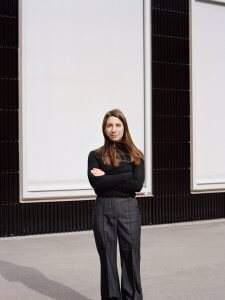Lorenza Longhi: World of Yum Yum | Family Style
Mar 25 2024

Floral Fantasia
Lorenza Longhi’s flowers are rooted at the intersection of commodification, desire, and personal identity. Look closer at the petaled sculptures, and you’ll see they are looking back.
Lorenza Longhi’s camellias possess eyes that peer out from their hand-crafted petals. Some gaze directly, while others adopt a side-eye glance. For her first solo exhibition in the United States, “World of Yum Yum,” the Zürich-based artist has created a multi-sensory floral experience at the Swiss Institute of Contemporary Art. There, a series of photographs of artificial flower sculptures—each with a functional camera at the center—hang from the ceiling on movable panels. Frozen in bloom, the cyborg-like flower sculptures were handmade by Longhi using found fabric scraps and following step-by-step instructions on a YouTube tutorial for Chanel’s famous camellia.
The artist used her flowers’ spy cameras to record everyday sounds while walking in different cities. She also recorded background noises in her home and studio. At the Swiss Institute in New York, these purposefully poor-quality videos are shown on high-end speakers placed within wall-mounted boxes covered with the artist’s original floral print, in a series titled “Off Season,” 2024. The disorienting result simulates an ambient shopping mall soundscape. “There is this idea of walking past something that is trying to attract you, but in the end ends up confusing you,” the artist explained in a video for the show.
Longhi has addressed materiality and mass production throughout her practice. For her work Improved Accuracy II, 2019, she welded industrial fluorescent lights, leaving the joints unpolished and exposing the imperfections and labor. The sculpture, both sterile and uncanny, reconfigures the institutional and corporate qualities of the lights so that their impartial utility fades away. In her 2019 exhibition “You’re In Business? I’m In Business” at the Plymouth Rock space in Zürich, Longhi used discarded materials to craft life-size reproductions of USM Haller furniture, iconic in Swiss design. Again these replicas, once symbols of quality and luxury, underscore the precarious and excessive use of these design objects.
“World of Yum Yum,” takes its title from critic Rhonda Lieberman’s 1994 “Glamour Wounds,” in which Lieberman asserts—and Longhi emphasizes—that luxury commodities are band-aids that only offer a momentary escape from insecurities. “It describes the feeling you have when you enter a Chanel store and you feel very inadequate and it just feels wrong and confuses you,” said Longhi of her exhibition. This belief is further highlighted in Longhi’s camellias. Acquiring commodities to boost self-esteem is like a flower blooming in a garden: It will eventually wilt. When viewed as a whole, the show is an immersive, sensorial journey that offers a thought-provoking exploration on commodification and its intersection between personal indulgence and the meaning of materiality.
